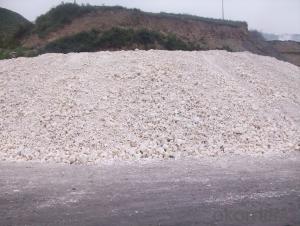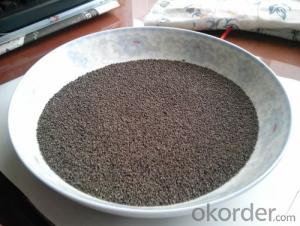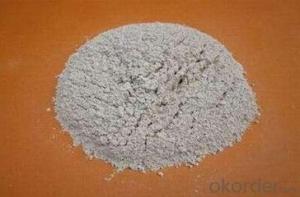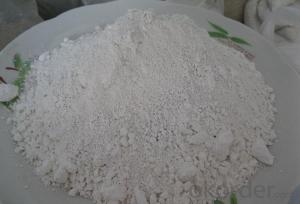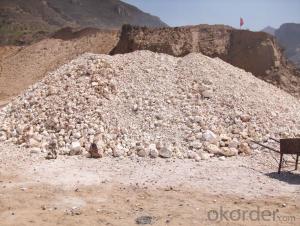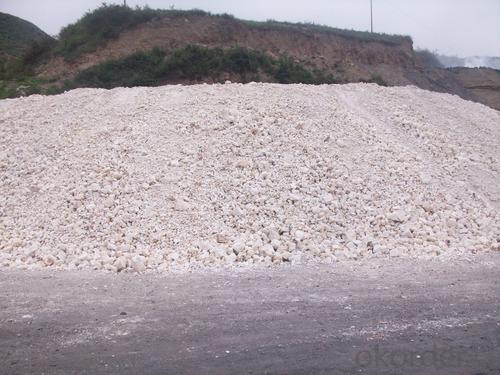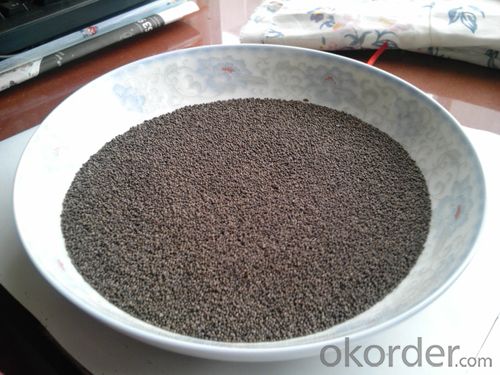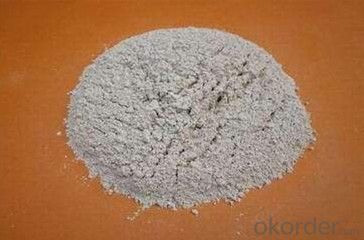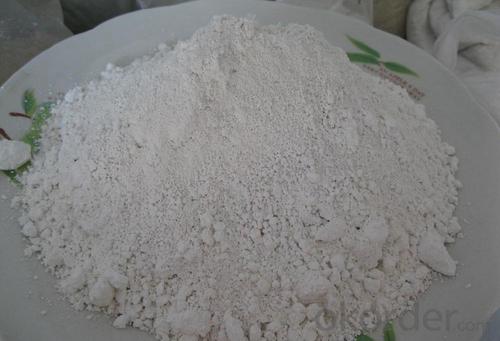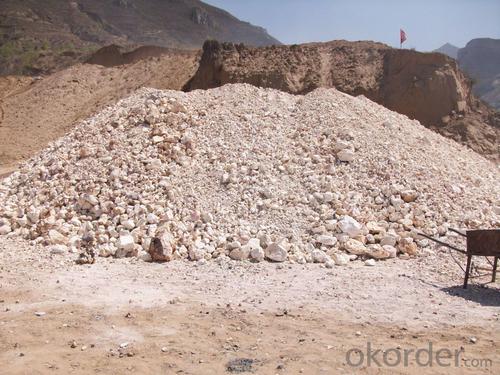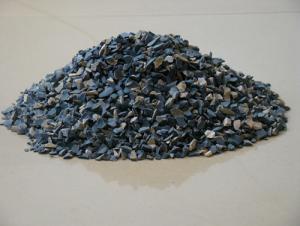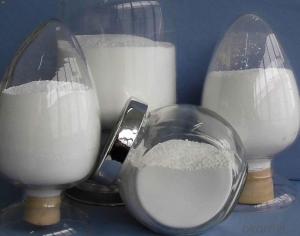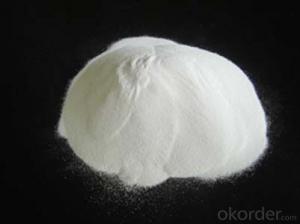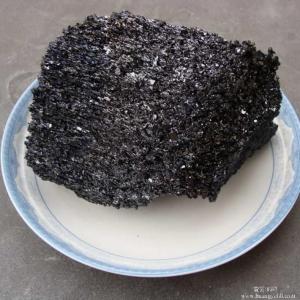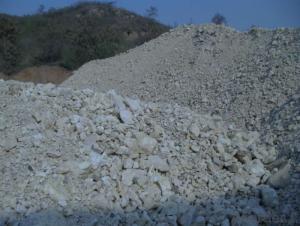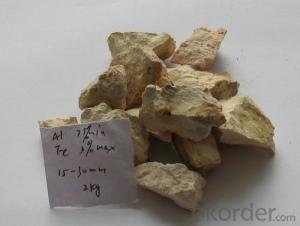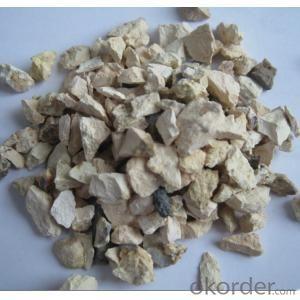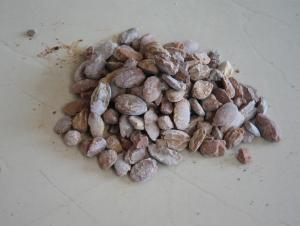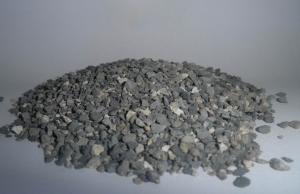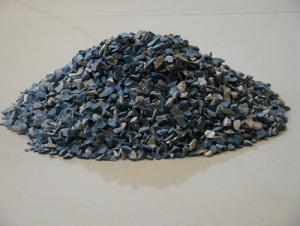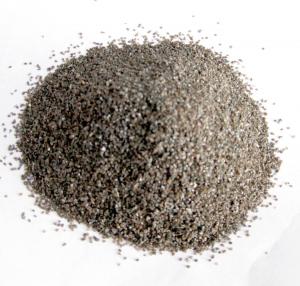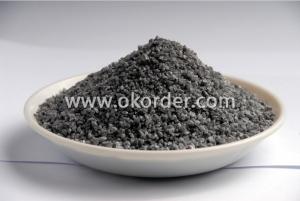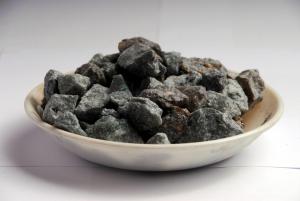Raw Materials for Refractory:79% Rotary/Shaft/Round Kiln Alumina Calcined Bauxite
- Loading Port:
- Tianjin
- Payment Terms:
- TT OR LC
- Min Order Qty:
- 25 m.t.
- Supply Capability:
- 3000 m.t./month
OKorder Service Pledge
OKorder Financial Service
You Might Also Like
79% Rotary/ Shaft/ Round Kiln Alumina Calcined Bauxite Raw Material for Refractory
Specification:
shaft kiln calcined bauxite:
Al2O3:84.0% MIN Fe2O3:2.%MAX TiO2:4.0% MAX Cao+MgO:0.4% MAX K2O+Na2O:0.25%MAX
Bulk Density:2.9 g/cm3 MIN MOISTURE:4.0%MAX
SIZE:0-1MM 1-3MM 3-5MM 0-5MM 5-8MM 0-50MM
100 MESH 120 MESH 150 MESH 200 MESH 325 MESH
Price:
0-50mm USD 270/MT FOB Tianjin
0-1mm 1-3mm 3-5mm 0-5mm 5-8mm USD 305/MT FOB Tianjin
200 mesh USD323/MT FOB Tianjin
Size of 79% Rotary/ Shaft/ Round Kiln Alumina Calcined Bauxite Raw Material for Refractory::
Lumps /Grains:0-1mm,1-3mm,3-5mm,5-8mm /Powders:100mesh, 200mesh,325mesh
Calcined Bauxite Grade:
1.Refractory Grade: |
Refractory grade bauxite has high refractoriness, good mechanical strength and moderate slag resistance. Bauxite in the refractory industry is typically used in ladle working lining, tundish furniture, delta sections, general perpose repairment, aluminium melting furnace and mineral processing.
3. Rotary calcined bauxite: |
Rotary Kiln Bauxite, as the name suggests, it is the bauxite produced by rotary kiln. there are three kinds of kilns for bauxite production mainly, rotary kiln, shaft kiln and round kiln.
4. Shaft kiln calcined bauxite: |
Shaft kiln bauxite, the bauxite calcined by shaft kiln. the raw material-bauxite ore is loaded from the top of kiln together with coal powder and combustion improver,the fire of calcination comes from kiln bottom, about 1300-1400 ℃After the complete calcination, the bauxite is carried out from the bottom.
Packaging & Delivery
Packaging Details: In bulk or in 1-1.25mr bag
Product Pictures:
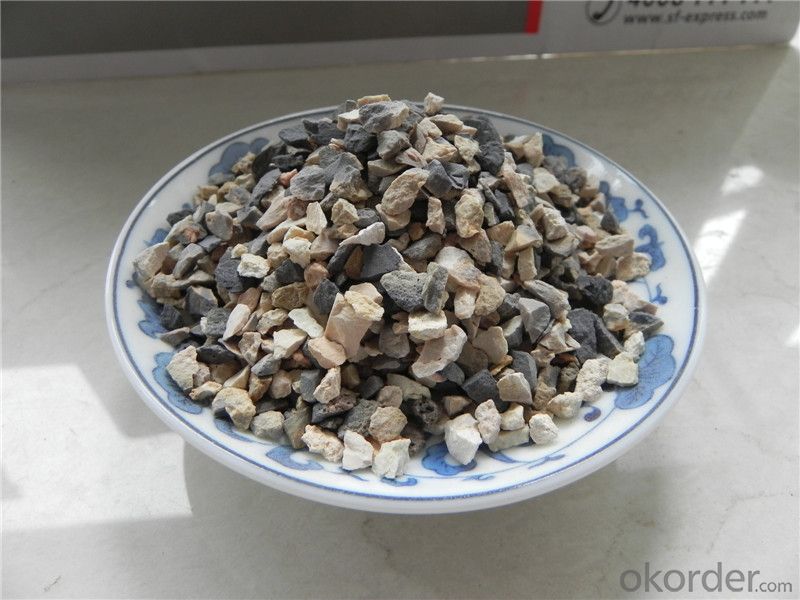
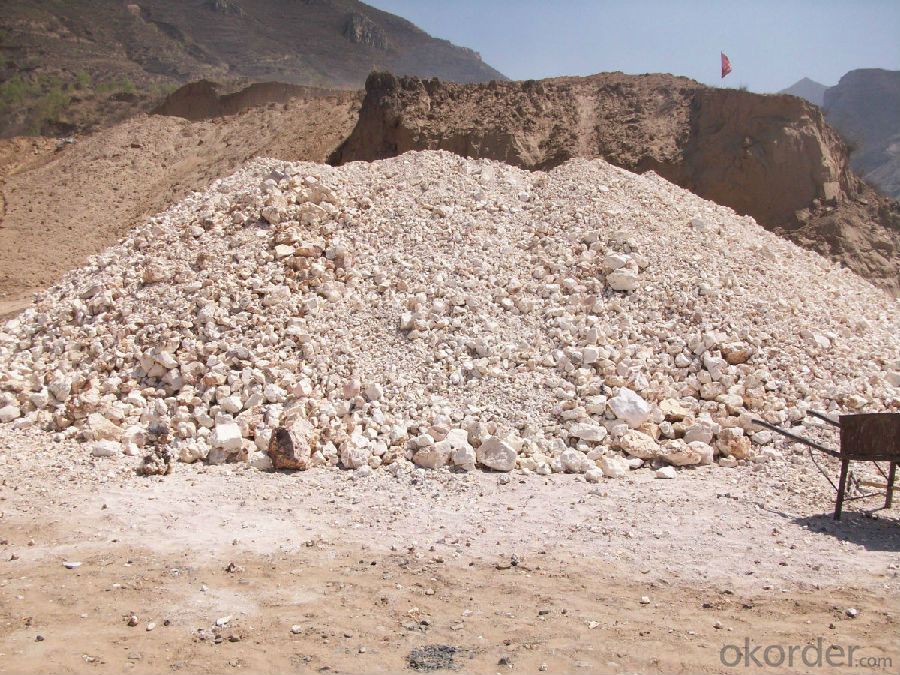
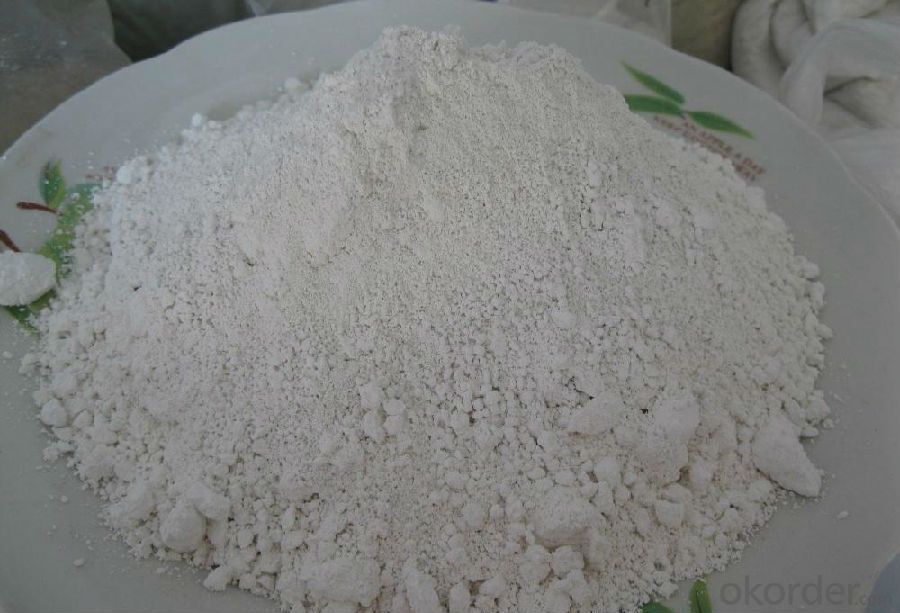
Our Service:
1. Your inquiry related to our products or prices will be replied in 24hours.
2. Manufacturer with large capacity, ensure the fast production cycle after confirmed the order.
3. Our professional technicians will answer your entire enquiry in patient.
4. To meet the refractory solutions, we can serve as your instructions.
5. Protection of sales area and private information for our entire customer.
If you’ve kind enquiries, please don’t hesitate to let us know. ^_^
- Q: What are the fire endurance requirements of class A fire resistant door ?
- The fire endurance of class A fire resistance door is 1.5H, but also depends on the product quality. The filling material of class A, B, C fire doors is the same, new fireproofing material-- perlite. The difference is their thickness. The general structure is: surface panel, fireproof?board framework (filled with perlite) fireproof?board panel. !
- Q: As for fireproofing material rock wool and glass wool, which one is better?
- First of all, glass wool and rock wool fireproof materials, rock wool and glass wool belong to Class A fireproofing rating, secondly, rock wool can endure high temperature of 800 degrees, glass wool high temperature of 450 degrees, again,unit weight of rock wool is relatively heavier and unit weight of glass wool is lighter, finally, glass wool has better waterproof performance.
- Q: How to divided the grade of external wall thermal insulation materials?
- Synthesized the three versions of GB8624 (1997,2006,2011), external wall thermal insulation fire?rating can be basically divided into: A1, A2, B1, B2, B3 and other levels. There are many technical indicators to make specific division, but I partly cannot report for a while, because it is very professional and technical. I hope I can help you!
- Q: How long is the duration of fire resistance that fireproof door of level B can endure?
- Level B refers to the fire resistance rating and different hours in fireproofing of the fireproof door. Fireproof door of level A can endure fire for 1.5 hours while level B 1.2 hours
- Q: What kind of refractory bricks material is best?
- Domestic experimental electric furnace body is made up of hearth, insulating layer and shell. Sic and high-alumina material are often used in traditional electric furnace under 1300℃ traditional furnace, while corundum material is used in 1600℃. Laboratory furnace of Occident usually uses ceramic fiber tank which is characterized by rapid temperature raising, good accuracy, light weight and small volume. In recent years, domestic Hangzhou blue sky Instrument and Shanghai laboratory equipment all have been produced by experimental furnace with ceramic fiber tank.
- Q: What are the materials used in refractory material processing?
- Refractory materials generally refer to inorganic non-metallic materials with a refractoriness of more than 1580 degrees. It includes natural ore and a variety of products made by a certain process according to certain requirements. It has certain high temperature mechanical properties and good volume stability. It is the necessary material for all kinds of high temperature equipment. Ordinary refractories are often used brick, semisilica brick, clay brick, high alumina brick, magnesia brick etc..
- Q: What is the mechanism of the errosion of the iron to the refractories?
- For example, the effect of the iron oxide: Mo corundum given temperature Fe2O3 solid solubility limit of the solid solution formed of corundum stone high solubility than the solid solution Mo Mo corundum lattice shape so Fe2O3Al2O3-SiO2-based material starts melting temperature of the system or the content of Al2O3 and Al2O3 / SiO2 ratio off Al2O3 / SiO2 & lt; 2.55 starting melting temperature of 1380 ℃ when Al2O3 / SiO2 & gt; 2.55 start melting temperature is increased 1460 ℃ and with its Al2O3 content increased gradually to increase the original atmosphere Fe2O3 original FeO off the solvent into the glass phase and the system starts melting temperature drops do not fall to 1240 ℃ 1380 ℃. Lower the melting point, increase the erosion, and reduce the life span.
- Q: Introduction to refractory material
- The best way to learn is on-site contact. If for produing purpose, it is better to ask teh leader of a plant. If for application, go to steel mill (cement plant, glassworks, etc.) to learn and look up information. Theory alone is of no help.
- Q: What are fire resistant level standards of class A fire resistant door?
- Situations under which fire endurance should at least meet class A fire resistant door standard: In basement, the fire door for room where the stored combustibles average weight exceeds 30kg/㎡; in partition basement, the fire door for partition of room where the stored combustibles average weight exceeds 30kg/㎡; in high building, the fire door for equipment room of automatic fire extinguishing system, fan room and air-conditioner room; in boiler room, transformer?cabin, diesel?generator room(other dangerous rooms), the fire door in firewall. These places are special and need high security, so they need to meet the standard of class A fire resistant door. What is class A fire resistant door? New Standard for Fire Door GB12955-2008 provides that class A fire resistant door thermal insulation and refractory integrity should be no less than 1.5 hours. In other words, the key of fire door grade is the fire-resistant time. Class A fire resistant door size: class A fire resistant doors have many sizes, and can be customized according to the needs of customers. For example, the size of some fire doors of the diesel generator room is large, while the size of fire doors of basement storing combustibles is small. So the size of class A fire resistant door is also different. Usually Xinduo will take this into account, produce class A fire resistant door with various sizes and can customize according to customer requirements. Class A fire resistant door standard: as is mentioned above, for class A fire resistant door standard, the key is the fire resistant time, no less than 1.5 hours. In texture, class A fire resistant door standard is manifested in the firm joint, uniform distribution of solder joints and smooth surface coating. It has also set fireproof sealing strip which should be straight.
- Q: What are the additives and recipes of refractory?
- Water reducing agent is to evidently reduce mixing water content while keep the slamp value of refractory castable almost invariant, also known as fluid loss agent. Water reducing agent itself cannot have chemical reaction with material component or compose new chemical compound, but it just seemingly has physical and chemical reactions. The binding agent of refractory castable is calcium aluminate cement combined with clay and oxide micro powder. In commonly used water reducing agents, the inorganic includes sodium pyrophosphate (Na4P2O7), sodium tripolyphosphate (Na5P3O10), sodium hexametaphosphate [(NaPO3) 6], super sodium polyphosphate (Na2P4O11), sodium silicate (Na2O · nSiO2 · mH2O), and so on; the organic includes lignosulphonate water reducer (sodium lignosulphonate, calcium lignosulphonate); naphthalene water reducer (naphthalene sulfonate or naphthalene homologues with formaldehyde condensate): water soluble resin water reducing agent (sulfonated melamine formaldehyde resin, abbreviated as composite of melamine water reducer).
Send your message to us
Raw Materials for Refractory:79% Rotary/Shaft/Round Kiln Alumina Calcined Bauxite
- Loading Port:
- Tianjin
- Payment Terms:
- TT OR LC
- Min Order Qty:
- 25 m.t.
- Supply Capability:
- 3000 m.t./month
OKorder Service Pledge
OKorder Financial Service
Similar products
Hot products
Hot Searches
Related keywords
